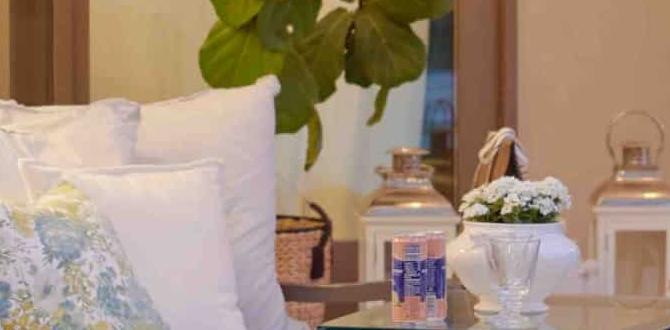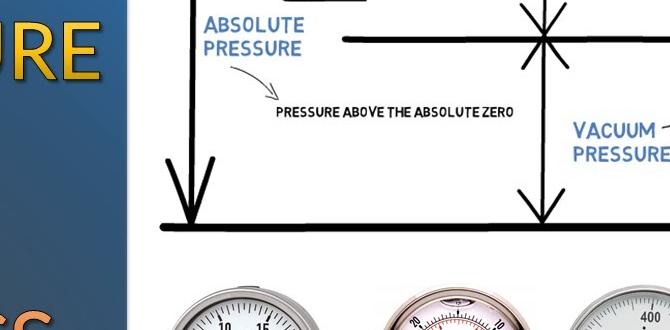Have you ever thought about how nice it would be to have a garden on your porch or balcony? Flower container gardening for beginners can turn any small space into a colorful oasis. Imagine bright blooms surrounding you as you sip your morning coffee or relax after a long day. It’s like bringing a little piece of nature right to your home.
Container gardening is simple and fun. You don’t need a big yard or a lot of experience. All you need are a few pots and some soil. You can choose your favorite flowers and watch them grow. Did you know that even small spaces can produce beautiful plants? It’s true! You can create a lively garden in just a few containers.
In this article, we’ll explore the basics of flower container gardening. We’ll help you get started, even if you’ve never planted anything before. So, are you ready to dig in and discover the joys of gardening in containers? Your journey to a blooming paradise begins here!
Flower Container Gardening For Beginners: A Simple Guide
Flower Container Gardening for Beginners
Starting a flower container garden is easier than you think! You can brighten up your space with colorful blooms right on your porch or balcony. Choose the right containers, soil, and flowers to match your style and climate. Did you know that container gardening allows for easier care and less pest trouble? Plus, it’s a perfect way to enjoy fresh flowers all season long. Are you ready to dig in and start your blooming adventure?Understanding Flower Container Gardening
Definition and benefits of container gardening. Difference between traditional gardening and container gardening.
Container gardening is growing plants in pots or other containers instead of in the ground. This method offers several benefits. It allows for easy movement, better control of soil quality, and a chance to brighten up small spaces. Unlike traditional gardening, which often needs more space and soil preparation, container gardening fits almost anywhere. You don’t have to dig up your yard or deal with poor soil, making it perfect for beginners.
What are the benefits of container gardening?
Container gardening has many perks! Here are a few important ones:
- Perfect for small spaces
- Easy to care for
- Can grow in any season
- No need for rich ground soil
- Portable for sun and shade
With fewer worries, you can focus on growing beautiful flowers easily.
Choosing the Right Containers
Materials and sizes of containers suitable for flowers. Drainage options and their importance.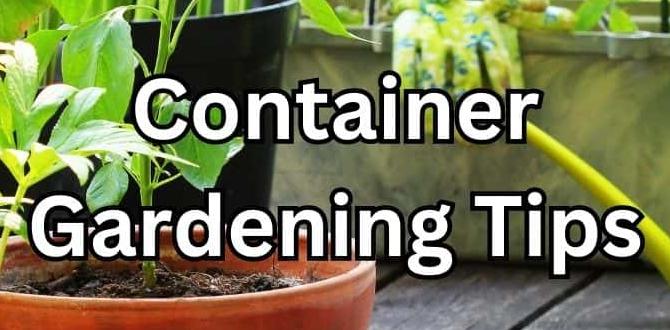
Picking the right containers is key for flower gardening. Many choices are available, like pots made from clay, plastic, or metal. Each material has its pros. Some are lightweight, while others are sturdy. You also need to think about sizes. Small pots work for tiny flowers, while larger ones fit bigger plants.
Good drainage is super important. Without it, roots can rot. Look for containers with holes at the bottom. If there aren’t any, you can add small stones for drainage. Healthy plants need the right containers!
What materials are best for flower containers?
Choose clay, plastic, or metal containers based on your needs.
Why is drainage important?
- Prevents water from blocking roots
- Avoids root rot
- Keeps plants healthy and happy
Selecting the Best Flowers for Containers
Types of flowers that thrive in containers. Seasonal considerations for flower selection.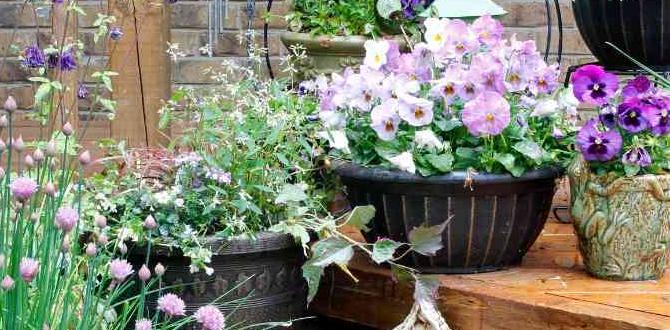
Picking flowers for your containers can feel like choosing your favorite candy. Sweet, colorful, and sometimes a bit sticky! Some flowers love to grow in pots, like petunias and geraniums. They’re like the life of the party! Always check the seasons, too; some bloom in summer while others shine in winter. Using the right flowers makes your garden pop all year, and your neighbors will be asking to borrow your secret!
| Season | Flower Types |
|---|---|
| Spring | Daffodils, Primrose |
| Summer | Petunias, Lobelia |
| Fall | Asters, Mums |
| Winter | Pansies, Cyclamen |
So, choose wisely, and your container garden will be the talk of the town!
Soil and Nutrient Requirements
Best soil mixes for container gardening. Importance of fertilizing and nutrition tips.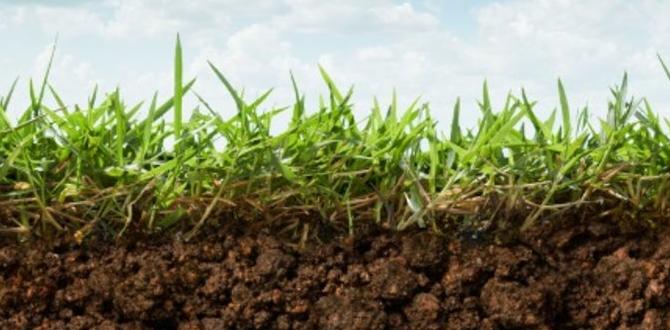
Using the right soil is key for container gardening. A mix of potting soil and compost works great. This mix holds moisture but still drains well. Fertilizing your plants helps them grow strong. Regular feeding keeps them healthy. Here are some important tips:
- Water your plants regularly.
- Use slow-release fertilizers.
- Check the soil for nutrients every month.
This way, your flowers will bloom beautifully!
What type of soil is best for container gardening?
The best soil for container gardening is a mix of potting soil and compost, which promotes good drainage and nutrient retention.
Watering Techniques for Container Flowers
Signs of overwatering and underwatering. Best watering practices for healthy flowers.Watering your container flowers can feel like a magic trick. Too much water, and they can drown, leading to sad, droopy petals. This is a sign of overwatering. Look for yellow leaves or mushy roots. Too little water, and they can become thirsty little plants with crispy edges. Signs of underwatering include wilting leaves and dry soil.
To keep your flowers happy, aim to water deeply but less often. This helps roots grow strong. A good rule of thumb is to check the soil. If it feels dry an inch below the surface, it’s time to hydrate! And remember, flowers can be like kids—too much attention can be just as bad as too little.
| Signs | Overwatering | Underwatering |
|---|---|---|
| Leaves | Yellowing | Crispy edges |
| Soil | Mushy, soggy | Dry |
| Roots | Rotting | Stunted |
Follow these best practices, and your container garden will thrive, just like your favorite sitcom—full of bright colors and laughter!
Sunlight and Location Considerations
Choosing the right spot for your flower containers. Understanding sunlight requirements for different flowers.
Finding the right spot for your flower containers is important. Most flowers need plenty of sunlight, but some prefer shade. Think about how much sun your area gets. Here are some tips:
- Choose a spot that gets 6-8 hours of sunlight a day for sunny flowers.
- For flowers that like shade, look for areas with 3-4 hours of indirect sunlight.
- Watch the spot throughout the day to see how the sun moves.
Remember, flowers love light! Making sure they have the right amount will help them grow strong and beautiful.
What if my area doesn’t get enough sunlight?
Consider using reflective surfaces like white walls or mirrors to boost sunlight. You can also try using shade-tolerant flowers, such as impatiens or ferns, that thrive in lower light.
Common Pest and Disease Management
Identifying common pests in container gardening. Organic and chemical solutions for pest and disease control.Pests can sneak into your garden like uninvited guests at a birthday party. Common pests include aphids, spider mites, and whiteflies. Always keep an eye out for tiny critters munching on your favorite plants! Don’t worry; control them easily. Just like superheroes, you have options! For organic solutions, try neem oil or insecticidal soap. If you prefer chemical methods, look for safe pesticides. They help keep your plants happy and healthy while sending pests packing!
| Pest | How to Identify | Organic Solution | Chemical Solution |
|---|---|---|---|
| Aphids | Small, green bugs on leaves | Neem oil | Insecticide |
| Spider Mites | Webbing on plants | Insecticidal soap | Pesticide |
| Whiteflies | Little, white flying bugs | Neem oil | Insecticide |
Remember, a happy garden is a pest-free garden!
Seasonal Maintenance Tips
Seasonal tasks for maintaining healthy flower containers. Preparing your containers for different seasons.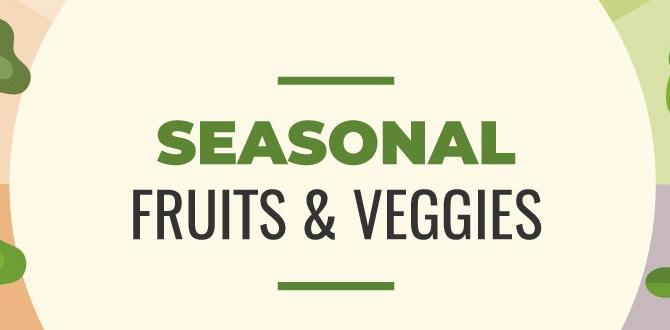
Taking care of your flower containers changes with the seasons. Each time, they need special attention. Here are some important tasks:
- In spring, check for dead plants and prepare soil.
- During summer, water daily and remove weeds.
- In fall, trim plants and add compost.
- Winter needs protection; bring containers indoors or wrap them.
Following these tasks helps your flowers stay healthy all year. Remember, a little care can bring big rewards!
What are some tips for seasonal maintenance of flower containers?
Seasonal maintenance of flower containers includes checking soil, watering, and protecting plants based on the weather.
Creative Arrangements and Designs
Inspiring ideas for flower container arrangements. Combining flowers with elements like foliage and decorative stones.
Think outside the pot! You can create beautiful flower container arrangements that will make your yard pop. Combine colorful flowers with lush green foliage for an eye-catching contrast. Want to add some sparkle? Toss in decorative stones for an extra layer of fun. It’s like giving your plants a stylish outfit!
| Arrangement Type | Flower Types | Decoration Ideas |
|---|---|---|
| Classic Layered | Petunias, Marigolds | Use pebbles for a neat look |
| Wild Child | Daisies, Zinnias | Add fun garden gnomes |
| Elegant Mix | Roses, Ferns | Include fairy lights |
Keep experimenting! The more you try, the more fun your garden will be. Remember, there’s no ‘wrong’ way to style your flower containers—just let your imagination bloom!
Resources and Tools for Container Gardening
Essential tools for beginners. Recommended resources for further learning.Getting started with container gardening is easy. You need some basic tools and helpful resources. Here are essential tools for beginners:
- Container: Choose a pot that fits your space.
- Potting Soil: Use good quality soil for your plants.
- Watering Can: A small can works well for careful watering.
- Gloves: Protect your hands while planting.
- Hand Trowel: Use this tool to dig and plant.
For more learning, check these resources:
- Online Gardening Courses: Websites offer great tips.
- Books: Find beginner gardening books at the library.
- YouTube: Watch videos to see gardening in action.
What tools do I need for container gardening?
You need a container, potting soil, watering can, gloves, and a hand trowel.
Conclusion
In conclusion, flower container gardening is a fun and easy way to enjoy plants. You can grow beautiful flowers even with limited space. Start by choosing the right containers and soil. Remember to water regularly and provide enough sunlight. We encourage you to try it out! Explore more tips and plant choices to make your garden thrive.FAQs
What Are The Best Types Of Containers For Growing Flowers In A Home Garden?The best types of containers for growing flowers are pots, raised beds, and hanging baskets. You can use plastic, clay, or wood for your pots. Make sure they have holes at the bottom for water to drain. This helps the flowers grow strong and healthy. Choose a size that fits your flowers well!
How Do I Choose The Right Soil And Drainage For Container Gardening?To choose the right soil for container gardening, pick a potting mix designed for containers. This mix helps plants grow and gives them nutrients. For drainage, use pots with holes at the bottom. This allows excess water to escape, so your plants don’t get too wet. You can also add small rocks at the bottom of the pot to help with drainage.
What Types Of Flowers Are Best Suited For Container Gardening In Different Climates?For warm climates, you can grow sunflowers, marigolds, and zinnias. They love the heat and bright sun. In cool climates, try pansies, petunias, and snapdragons. These flowers like the cooler temperatures. Always choose flowers that match your weather for the best results!
How Often Should I Water And Fertilize My Container Flowers?You should water your container flowers every day or every other day, especially when it’s hot. Stick your finger in the soil; if it’s dry, it’s time to water. For fertilizer, use it every 4 to 6 weeks during the growing season. Follow the instructions on the fertilizer package for the right amount. This way, your flowers will stay healthy and bloom nicely!
What Are Some Common Pests And Diseases That Can Affect Container Flowers, And How Can I Manage Them?Some common pests that can harm container flowers are aphids and spider mites. Aphids are tiny bugs that suck the juice from plants. Spider mites are very small and create webs. You can manage them by washing the plants with water or using insect soap. Common diseases include powdery mildew and root rot. Powdery mildew looks like white dust on leaves, while root rot means the roots are too wet. To prevent these, make sure your flowers get good air and don’t get too much water.
{“@context”:”https://schema.org”,”@type”: “FAQPage”,”mainEntity”:[{“@type”: “Question”,”name”: “What Are The Best Types Of Containers For Growing Flowers In A Home Garden? “,”acceptedAnswer”: {“@type”: “Answer”,”text”: “The best types of containers for growing flowers are pots, raised beds, and hanging baskets. You can use plastic, clay, or wood for your pots. Make sure they have holes at the bottom for water to drain. This helps the flowers grow strong and healthy. Choose a size that fits your flowers well!”}},{“@type”: “Question”,”name”: “How Do I Choose The Right Soil And Drainage For Container Gardening? “,”acceptedAnswer”: {“@type”: “Answer”,”text”: “To choose the right soil for container gardening, pick a potting mix designed for containers. This mix helps plants grow and gives them nutrients. For drainage, use pots with holes at the bottom. This allows excess water to escape, so your plants don’t get too wet. You can also add small rocks at the bottom of the pot to help with drainage.”}},{“@type”: “Question”,”name”: “What Types Of Flowers Are Best Suited For Container Gardening In Different Climates? “,”acceptedAnswer”: {“@type”: “Answer”,”text”: “For warm climates, you can grow sunflowers, marigolds, and zinnias. They love the heat and bright sun. In cool climates, try pansies, petunias, and snapdragons. These flowers like the cooler temperatures. Always choose flowers that match your weather for the best results!”}},{“@type”: “Question”,”name”: “How Often Should I Water And Fertilize My Container Flowers? “,”acceptedAnswer”: {“@type”: “Answer”,”text”: “You should water your container flowers every day or every other day, especially when it’s hot. Stick your finger in the soil; if it’s dry, it’s time to water. For fertilizer, use it every 4 to 6 weeks during the growing season. Follow the instructions on the fertilizer package for the right amount. This way, your flowers will stay healthy and bloom nicely!”}},{“@type”: “Question”,”name”: “What Are Some Common Pests And Diseases That Can Affect Container Flowers, And How Can I Manage Them? “,”acceptedAnswer”: {“@type”: “Answer”,”text”: “Some common pests that can harm container flowers are aphids and spider mites. Aphids are tiny bugs that suck the juice from plants. Spider mites are very small and create webs. You can manage them by washing the plants with water or using insect soap. Common diseases include powdery mildew and root rot. Powdery mildew looks like white dust on leaves, while root rot means the roots are too wet. To prevent these, make sure your flowers get good air and don’t get too much water.”}}]}



